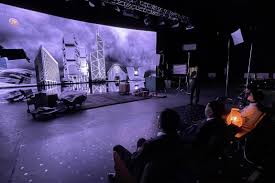PROJECT
"A study on how Unreal engine, Metahumans, Augmented reality (AR) and LED wall technology can enhance viewer's experience while watching sports, and News broadcasting".
Hypothesis
Integration of metahuman characters with augmented reality (AR) graphics, utilizing LED wall virtual production technology, significantly enhances the viewer's immersive experience and emotional engagement in television.
This approach provides a more realistic and seamless fusion of digital and real-world elements, effectively reducing cognitive dissonance and increasing the perceived authenticity of virtual scenes.

Unreal engine for virtual studios.
Virtual production with LED walls, a cutting-edge technology, has influenced both news and entertainment industries in a broader aspect. This technology enables us to have the feasibility to work on real-time modifications with the help of game engines like Unreal engine, which allows real time 3d graphics rendering and immersive environments. According to the team at Weta Digital (a company that develops digital visual effects for films and television), "Virtual production is where the digital and physical worlds meet" in real-time as they are composed and captured 'on set', by combining physical sets with props and camera tracking technologies for both film and broadcasting industries. (Kadner, 2019).

METAHUMANS IN BROADCASTING TECHNOLOGY
Metahuman creator was officially launched in February 2021 by Epic games – a game development company. This technology helps us to create realistic digital characters within minutes, which also includes pre-set facial expressions, hairstyles, body types, and animations. The characters can be used for gaming environments, VR experiences, and also animated films. Metahumans are advanced digital humans with enhanced visual and functional capabilities. (Gawand and Demirel 2020b).

AR GRAPHICS IN BROADCASTING WITH VIRTUAL PRODUCTION.
Augmented reality is a variation of a virtual environment or virtual reality as it is more commonly called. It gives us the visual images or datas over real time environments. AR is a technology that overlays onto the environment that we have created. This technology is also available on tablets, smartphones and game consoles. (Unreal Engine 2024) This technology has now captured many industries such as, Healthcare, Retail, Manufacturing, Entertainment and Education.
WORKFLOW TIMELINE


METHODOLOGY
CONTEXT
This research project focuses on the advancements in real-time rendering with Virtual Production and the creation of digital humans, which examines the audience's preferences and engagement with real and digital characters. Finally, the AR overlay graphics provide an immersive experience. The main aim is to study and provide a holistic understanding by integrating these cutting-edge technologies to enhance viewers' experiences. Secondly, this project gives me the exposure to learn new software and skill sets, which would help me develop a strong portfolio for my career.
DELPHI METHOD
The Delphi method is a structured approach to gaining consensus from a panel of experts through an iterative round of surveys. This project will require different types of questions, based on the area of research required. The initial process is to develop a virtual stage in Unreal engine with DMX lights and broadcasting environment. The second stage is to create a fully functional metahuman character and analyse its characteristics and opinions for the industry experts. The main reason for this methodology is to determine whether certain workflows and developments will require different practices.

INTERNAL TESTING
For this process, I am focussing on two software for the AR overlay graphics. (Lino - Zero-Density and Lucid - Ross Videos) I will be testing this software for my project and arrive at a conclusion about which software is suitable for my workflow. Recording my facial details and then using them for the Metahuman character for the initial testing process
Eos qui ratione voluptatem sequi nesciunt neque porro quisquam est qui dolorem ipsum quia dolor sit amet consectetur adipisci velit sed quia non numquam eius modi tempora incidunt ut labore et dolore magnam aliquam quaerat voluptatem ut enim ad minima veniam.

PRE- PRODUCTION
Unreal environments - Collect references like sketches and photos of existing virtual studios.
Metahumans - Create a character using Unreal Engine's metahuman creator and work on facial expressions, body language, and movements for emotional engagement.
AR Overlay graphics - Create AR graphics according to the theme of the content.
ETHICAL CONSIDERATIONS
- Deepfake concerns – To address ethical concerns regarding the potential misuse of hyper-realistic metahuman characters, such as creating deceptive or malicious content.
- Questionnaire - Collecting audience's feedback on the project, if they were able to understand the content, and if they feel any difference from the traditional methods.
- Sustainability - LED volumes consume a lot of energy. To reduce that, initial testing can be done with a Green matte or by creating Pre-vis so that the time taken during production is reduced.
- Legal - Use legally licensed software for AR graphics.
- Respect intellectual property rights for the Metahuman assets, AR graphics, and virtual production technologies used in the study.
- Ensure appropriate licensing for any third-party software or creative assets employed in the project. Be mindful of the emotional or psychological effects of highly realistic Metahuman characters.
- Consider the environmental impact of using High-powered LED walls for rendering graphics.
- GDPR - Participant's anonymity
SUSTAINABILITY
- Economical - Helps to reduce travel expenses and logistics wastages in shooting locations. However, initial setup cost is high.
- Ecological - The main advantage of Virtual production is that everything can be shot in a single location in indoor sets. Helps to reduce carbon footprints.
- Sociological - The increasing use of AR graphics and Metahuman characters raises the expectations of viewers for more immersive, lifelike, and interactive media experiences. Virtual production technologies may empower smaller studios, independent creators, and non-professional producers to create high-quality content that rivals major studio productions.


